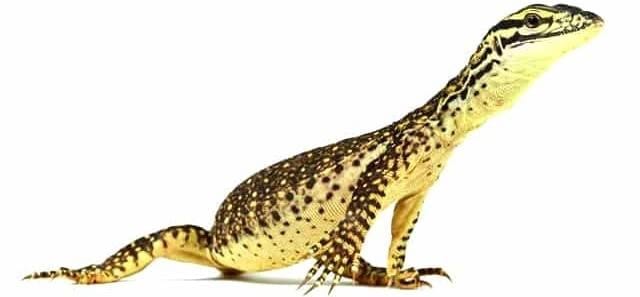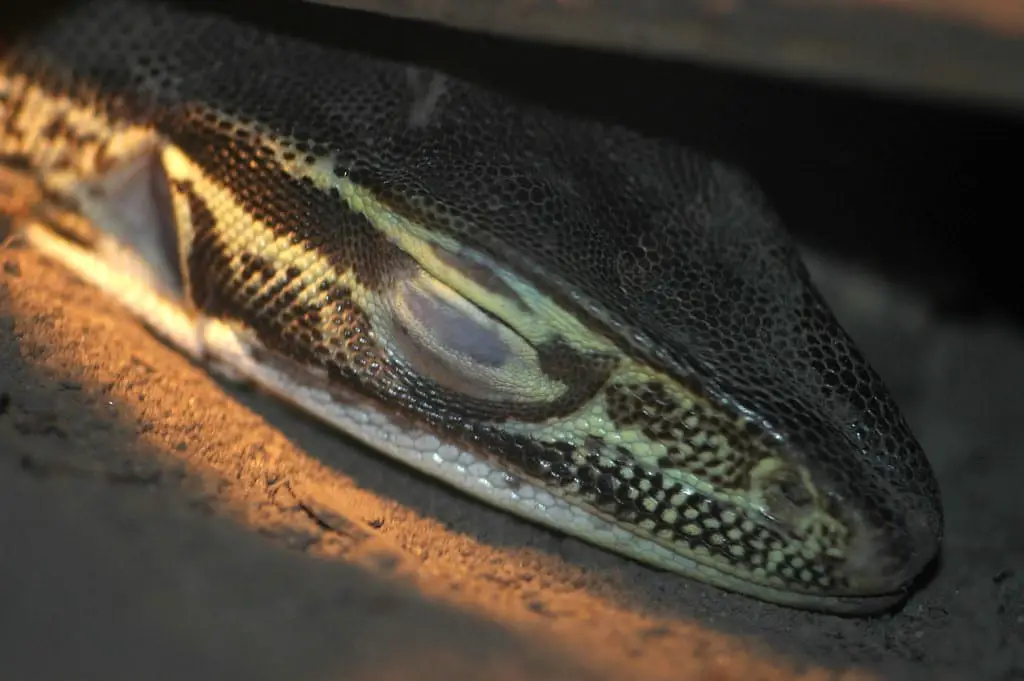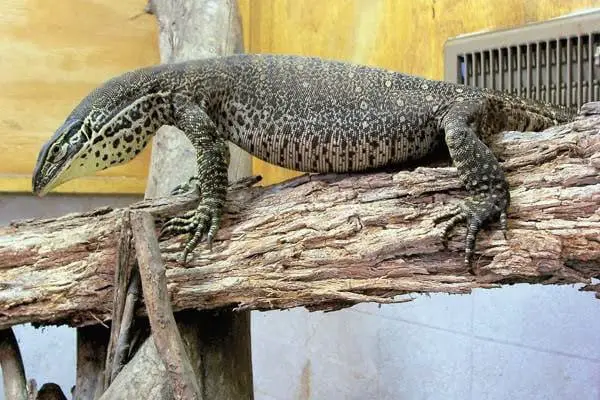Scientific Facts
| Common Name | Argus Monitor |
| Scientific Name | Varanus panoptes |
| Life Span | 12 to 20 years in captivity |
| Size | 10 to 12 inches as newborns, up to 5 feet as adults |
| Habitat | Savannah, grasslands, woodlands, and coastal regions |
| Country of Origin | Indonesia and Papua New Guinea |
Physical Description

The Argus Monitor is a type of pet reptile that does not grow to crazy sizes. They are usually manageable in terms of length and will grow up to a maximum of about 5 feet. These lizards are commonly yellow or off-white in their underbellies. However, the top or visible parts of their bodies are dark brown in color but are lined with small patterns of yellow or off-white. The dorsal area of the Argus Monitor may sometimes display reddish or grayish patterns.
An Argus Monitor’s tail commonly has yellow bands that extend all the way to the tip of the tail. However, there are some types of Argus Monitors that do not exhibit a yellow band at the tip of the tail. Regardless, it is easy to spot an Argus Monitor due to its predominantly yellowish and dark brownish appearance.
Some of the more defining physical attributes of an Argus Monitor are its front limbs. Compared to the rest of its body, this reptile’s front legs are large and muscular in terms of build and are commonly larger at the forearm portion much like Popeye. The purpose of these large front legs is to allow the Argus Monitor to efficiently dig and run at incredible and impressive speeds.
The hind legs are also muscular themselves and are able to carry the full weight of the reptile. These lizards have large and muscular hind legs because, at times, the Argus Monitor stands on its hind legs and uses the tail for balance. In the wild, this usually happens whenever they are running away from a potential threat. But when they are captive bred, Argus Monitors do this whenever they are surveying their surroundings. Both the front and hind legs have sharp claws at the tips.
Sex plays a role when it comes to the physical attributes of an Argus Monitor. Female variants of these reptiles are often smaller than the males. They rarely exceed 4 feet in length. Meanwhile, the males are larger and more muscular ones. It is believed that the males are generally larger because it allows them to excel in the ritual combat that Argus Monitors practice during mating season.
Lifespan
Argus Monitors live quite long whenever they are kept in captivity. With proper care and handling, most of these reptiles will be able to live at an average of 15 years though they commonly have a lifespan that exceeds 12 years. However, there are cases when an Argus Monitor can live to up to 20 years so long as they are given the best kind of care and nutrition and are housed in an environment that is more than suitable for them. In the wild, however, Argus Monitors are not expected to outlive their captive-bred counterparts because of how parasites, illnesses, and natural predators can potentially threaten their existence.
Eating Habits
Argus Monitors are carnivorous lizards that will eat almost anything that is meat in origin. They are also incredibly aggressive eaters that will eat what you will feed them as long as it is something that is meaty. So, basically, if it moves or if it came from an animal, the Argus Monitor will eat it. Some would even say that these reptiles are much more enthusiastic than other pet monitors when it comes to feeding tie as they are quick to understand and equate their owners to “meal time.” That means that they will know and understand that their owners are the source of their regular meals.
In the wild, Argus Monitors are hunters that will more than likely spot prey and then stalk it before catching it off guard. They can also dig the prey out of the ground using their sharp claws and their strong front limbs. That is Argus Monitors that live in the wild are most likely to feed on rodents that live underground by digging them out. Things are different when these reptiles are bred in captivity
When feeding neonates and juvenile Argus Monitors, it is best to introduce these reptiles to a diet that consists mostly of insects. If you can, feed them with gut-loaded crickets that were fed with vegetables to provide the juvenile Argus Monitor with the right kind of nutritious meal. Dust the crickets with calcium before feeding them to your reptile so that they will be able to balance out their calcium and phosphorous levels. You can also opt to feed your juvenile Argus Monitor with thawed pink mice or day-old chicks. So long as these prey items are small enough for them, the juvenile reptile will eat them. However, do take note that it is better to feed them with gut-loaded insects because you can provide them with essential vitamins and minerals in the process. Feed your juveniles on a daily basis and make sure to provide them with food that is high in calcium.
It is not recommended to feed your juvenile Argus Monitors with chicken or turkey meat or with eggs because these food items tend to have high phosphorous levels. However, as mentioned, Argus Monitors are not picky eaters and will eat almost anything that is meat in terms of origin. That means that you should try not to feed your juveniles with such types of food to avoid any health complications as they grow older.
As the Argus Monitor gets older, it is a good idea to feed them with larger whole-prey items such as bigger rodents, insects, fish, and even birds. You can even feed adult Argus Monitors with skeletal meat such as chicken and turkey. When feeding them with chicken or turkey meat, you can offer the food chopped or sliced because these reptiles are really enthusiastic about eating anything that is meat regardless of whether the food is alive or not or if it is given in whole or in smaller pieces. However, it is still better to feed them with gut-loaded and dusted insects because this type of diet gives is more nutritious for them.
Adult Argus Monitors need not be fed regularly or on a daily basis because these extreme eaters are prone to obesity. As much as possible, keep them on a strict diet and feed them once every few days, depending on the size of the meals. It might be a good idea to feed them twice or thrice a week.
Sleeping Habits

Argus Monitors are diurnal reptiles that are more active during the day and are less active during nighttime. That said, they are most likely awake for at least 12 hours during the daytime but will spend most of their evenings resting and sleeping.
Water
Argus Monitors are riparian in terms of their behavior and will most likely need to be near a permanent or consistent source of water. It is not uncommon to see these reptiles soaking their entire bodies in a body of water that is large enough for them. They will swim in the water from time to time to keep their bodies hydrated, especially when the air is low in terms of humidity. In that regard, try to make sure that you provide these reptiles with a large water dish that is not only ideal for drinking but also for soaking. However, do keep in mind that it is common to see the Argus Monitor defecating in water. That means that you should not only regularly change their water but also clean and disinfect the water dish. This helps in preventing illnesses caused by bacteria.
Development and Reproduction
Argus Monitors start out as hatchlings that are about 10 inches in length at first. However, as neonates and during their juvenile years, they are very quick to grow and will reach about 2 and a half feet in terms of length in just a year after hatching from their eggs. Often times, Argus Monitors can reach sexual maturity by this age. There are also those that will reach sexual maturity after just a year and a half. However, it is still better to wait for your Argus Monitor to reach 4 or 5 years old before attempting to have them reproduce.
How to Breed
It might be difficult to sex Argus Monitors when they are still neonates and during the first few years of their juvenile stage. However, this becomes easier to do when they get older and older. You can clearly separate the males from the females by judging their size and body build. The males are generally bigger and have muscular arms that allow them to excel well in combat. Males also tend to have thicker tails. Females rarely reach 4 feet in terms of length while the males are generally at least 4 and a half feet long.
After sexing your Argus Monitors, it is best to allow them to adjust to life living with another reptile of the same species because these lizards are not particularly fond of being with another Argus Monitor when they were raised solitarily. In that regard, it is best to use Argus Monitors that are adapted to living with their fellow lizards.
You would know that a female Argus Monitor is receptive to breeding when they are more bloated than usual and are displaying behaviors you are not used to seeing from them. Females also tend to eat more during this stage. You might want to increase the regularity of their feeding to allow them to build up the energy they need during reproduction.
After that, she will begin to release pheromones that will entice the nearby male. In the wild, it is common for all nearby males to undergo ritual mating combat to try to win the right to mate with the female. The strongest male naturally has the advantage and will most likely earn mating rights. This ritual combat is what is believed to be there a main reason why male Argus Monitors have such muscular arms.
In captivity, however, there is no reason for ritual combat to happen because you are naturally mating with only one male and one female. Once the male positions himself on the back of the female, mating happens. This may happen on and off until the female decides when it stops. A female that is no longer receptive to mating will stop emitting pheromones. At this point, she is most likely pregnant and is ready for egg development.
Common Health Problems
Argus Monitors may be very resilient and healthy reptiles that can possibly live up to 20 years when taken care of properly and when fed with a healthy and well-balanced diet, but they are still prone to illnesses and health problems that can potentially shorten their lifespan. In that case, it is best to keep an eye on what kind of health problems Argus Monitors often face so that it will be easier for you to do what is necessary to prevent such problems.
Obesity
Argus Monitors are generally very enthusiastic eaters that will eat almost anything you offer them so long as it is a meat prey item or it comes from meat. In that regard, they are prone to obesity, especially if you keep on feeding them without control on your part. When an Argus Monitor is obese, this opens them up to a lot of other life-threatening diseases. A fat reptile might be cute to look at, but being obese is never a good thing for them.
Metabolic bone disease
Metabolic bone disease is a common health problem for a lot of reptile species. This usually happens when their calcium and phosphorous levels are not balanced and that they have low blood calcium. This kind of disease starts out at tremors at first but will eventually transition to more serious symptoms such as fragile bones and joints, weak muscles, and fractured bones.
Parasites
Internal and external parasites are not usually common for captive-bred Argus Monitors except if you happen to house them in an environment that is less than suitable enough for them. However, this kind of health problem is very common for Argus Monitors that were caught in the wild. While wild-caught reptiles are usually built to be resistant to parasites, being transported, and adjusting to a new environment can potentially be too stressful for them to the point of weakening their immune system. In such a case, they will be open to the ill effects of internal parasites.
Preventing Illness
Knowing the common health problems that Argus Monitors often face is the first step to preventing illnesses. The next step is to know how to deal with such illnesses before they manifest. As such, it is best to make sure you feed your Argus Monitors properly and to have them maintain a healthy and balanced diet to prevent complications that come from obesity and metabolic bone disease. Make sure to gut-load insects and to dust them with calcium to level out your reptile’s calcium and phosphorous levels. A vitamin D3 supplement or ultraviolet B lights can also help. Keeping your Argus Monitor’s habitat clean is the best way to keep them away from bacteria as well as possible infections caused by parasites.
In all other cases, it is better to have a good veterinarian check up on your Argus Monitor from time to time, especially if they are displaying some symptoms of common health problems. Know the vets that specialize in exotic pets and in reptiles so that you can minimize the risk of a wrong diagnosis from a vet who is not used to handling reptiles such as Argus Monitors.
Behavior
The Argus Monitor is not an aggressive reptile in the strict sense of the word. In a way, this lizard is actually pretty defensive, especially when they feel aggression from someone approaching them. But, if they get used to you, they are not exactly shy types. Argus Monitors are active and very curious. They are not like other monitor lizards that are quite lazy because these reptiles are a joy to look at even if you are just observing them in their habitat.
Here are some common Argus Monitor behaviors:
Standing
Argus Monitors are fun to look at because they love standing on their two hind legs while using their muscular tails for balance. This reptile, in the wild, usually does that when they are trying to run away from a threat. But, in captivity, they do that because they like observing their environment. Standing can give them a better vantage point.
Climbing
If you have anything that can be used for climbing, you might see your Argus Monitor attempting to climb it from time to time. Though they are not arboreal reptiles, these lizards are pretty active and will sometimes try to climb up objects. However, they are quite the clumsy climbers and may sometimes fall off while trying to climb an object.
Running
Argus Monitors are very quick runners and are faster than even the fastest person you know. The moment they sense a bit of freedom when they are let loose outdoors, they will run off in a hurry, and you won’t be able to catch up to them unless they actually stop running. As such, better keep your Argus Monitor inside its enclosure. Or, if you really want to let them loose, put them on a leash so as to make sure that they do not run off far from you.
Hibernation Cycle
Argus Monitors live in places where there are only hot and rainy seasons. They do not regularly experience winters or cold seasons. As such, these reptiles are not known to hibernate whenever the seasons get colder. Despite that, during the winter, you might see decreased activity from these reptiles. If you do not want them getting too cold, keep an eye on the temperature levels in their enclosure and make sure to provide them with the heat they need.
Shedding
Like most other reptiles, Argus Monitors do shed their old skin to make way for new skin to grow. This usually happens when they are in the middle of rapid growth during their juvenile years. However, unlike snakes, shedding in Argus Monitors is not a large single event. Instead, shedding happens gradually. You may see them shedding a few pieces of skin from their belly one day and then on their legs on another day.
Habitat

The most important aspect when it comes to your Argus Monitor’s habitat is that it should be big and wide enough for these lizards. That is because these reptiles tend to be very active. They like moving around in their habitat while observing their environment. In some cases, they even climb up whatever they can climb. They are simply energetic types of monitor lizards and require a lot of space for them to make good use of their energy.
In that case, makes sure to house your Argus Monitor in an enclosure that is no shorter than 8 feet in length and 5 feet in width. You may even want to use an enclosure that is about 5 feet in terms of height to provide these lizards with objects they can climb on. You may construct your own enclosure made out of plywood, but you can also use a sturdy aquarium. If you want to use plywood, use wooden support beams, and then make sure that there is a glass window that will allow you to observe what the reptile is doing. Keep the top of the enclosure secured so as to prevent them from trying to climb their way out of their habitat. You can place objects such as sturdy plants or small trees for your Argus Monitor to climb on.
Lighting and Humidity
Argus Monitors are diurnal reptiles that are active during the day and sedentary or asleep at night. That means that you should provide them with about 12 hours of lighting during the day and total darkness at night. Use several light sources for your reptile during the day. You may want to use an ultraviolet B lamp to provide the enclosure with light and a vitamin D3 source for your Argus Monitor. You may also use hotter sources of light, such as an incandescent bulb to provide light and heat at the same time.
These reptiles are used to environments that are quite humid. Always make sure to keep their enclosure humid enough by placing a large water dish that increases the humidity in the environment while also providing your lizard with a way to keep itself hydrated both internally and externally. Another way of keeping humidity levels up is to mist the enclosure regularly with water. One way of knowing that the humidity levels are right for your reptile without the need for any special equipment is to look at the substrate, which should be damp but not too wet. Keep humidity levels over 70% but not more than 80% to prevent molds and bacteria from propagating.
Temperature
Argus Monitors love environments that are warm or hot enough for their cold-blooded bodies. The air temperature inside the enclosure should be above 75 degrees Fahrenheit at the coolest and then up to 100 degrees at the warmest part of the enclosure. You can use different sources of heat to achieve this. In the cooler portion, you may want to keep a UVB lamp. Meanwhile, in all other parts of the enclosure, a strong light source such as a heat lamp should do the trick. At night, however, you may want to use a heating pad, especially during the winter seasons.
Keep a basking area that is about 115 degrees Fahrenheit. Reptiles like to bask under the heat whenever they are metabolizing their meals because this allows them to digest their food better. Females as well love basking whenever they are receptive to mating.
Sanitation
Argus Monitors are known to defecate in their water source whenever they are soaking themselves. In that case, it is best for you to make sure you always replace their water source as well as sanitize their water dish. Cleaning the entire enclosure on a regular basis also prevents molds, bacteria, and parasites from building up and potentially causing harm and illnesses to your Argus Monitor.
Natural Environment – Substrate
Argus Monitors are natural diggers that love using their large and muscular front lips to dig through the ground with efficiency. To promote this kind of behavior, you might want to use a substrate that mimics soil as much as possible if you cannot use soil. Mulch might be a good idea. Also, make sure that the substrate is deep enough for your Argus Monitor to dig through. Maybe a substrate that is about 2 feet is enough. Try not to use commercial potting soils because they contain chemicals that may harm the lizard.
Hydration
Argus Monitors need a lot of water because of how active they are and because of how they need to keep their entire bodies hydrated in a very hot environment. Keep a large water dish that has three purposes: one, to provide a source of drinking water; two, so that your Argus Monitor has something to soak their bodies in; and three, to keep the humidity levels in the enclosure up. Make sure that the water dish is large enough to fit the entire Argus Monitor.
Availability – Where to Get One?
The Argus Monitor is available for purchase in many different reptile breeders in your locality. You may want to check online if you want to compare prices or if you want to get the best Argus Monitor from the most reputable breeders. These lizards tend to be quite pricey compared to other monitor lizards. They are usually more than $200 but are not more expensive than $500.
How to Care for an Argus Monitor?
Here are some tips on how to care for an Argus Monitor:
- Feed them with gut-loaded insects that are sprinkled with calcium to make sure they get the optimum nutrition they need to live long and to function healthily.
- Try to keep their enclosures tightly sealed to prevent them from escaping. It will be difficult to chase them around when they start running.
- They are typically quite defensive, especially if they feel threatened, but they will be receptive to handling if they already recognize you as their owner.
- House them in an enclosure that is quite spacious because they are very active types of reptiles.
FAQs
Are Argus Monitors venomous?
Argus Monitors do not contain any venom, but their bites may cause bacterial infections if not treated right away.
Are Argus Monitors good for beginner owners?
Probably not. Argus Monitors are not always safe for handling and are not good for beginners but are better off for intermediate pet owners who are already content with just watching and observing these reptiles.
How often should you feed your Argus Monitor?
Juvenile Argus Monitors should be fed daily. As they grow older, try to trim the feeding down to about three to four times a week, depending on how large their meals are.
Can Argus Monitors eat vegetables?
Argus Monitors are strictly carnivorous reptiles that rely on meat for their nutrients. If you want a complete and well-balanced diet, feed them with insects that are gut-loaded with nutritious vegetables.
How big do Argus Monitors get?
Argus Monitors grow up to 5 feet in length if they are males. Females are typically under 4 feet in length.
Are Argus Monitors safe for handling?
It really depends. There are Argus Monitors that can be handled safely by their owners after they have recognized them to be their handlers while some of these reptiles are quite defensive in nature and may bite you if they think that you are a potential threat.
Is it safe to put two or more Argus Monitors in one enclosure?
Yes, it is. Argus Monitor breeders typically raise their reptiles together because these lizards tend to act differently towards a potential mate when they are used to living a solitary life.
Why do Argus Monitors stand on their hind legs?
Argus Monitors typically display a tripod-like behavior where they stand on their hind legs while using their tails for balance. They usually do this in the wild if they are running from the threat, but they also do this to provide them with a better vantage point when they are observing their environment.


